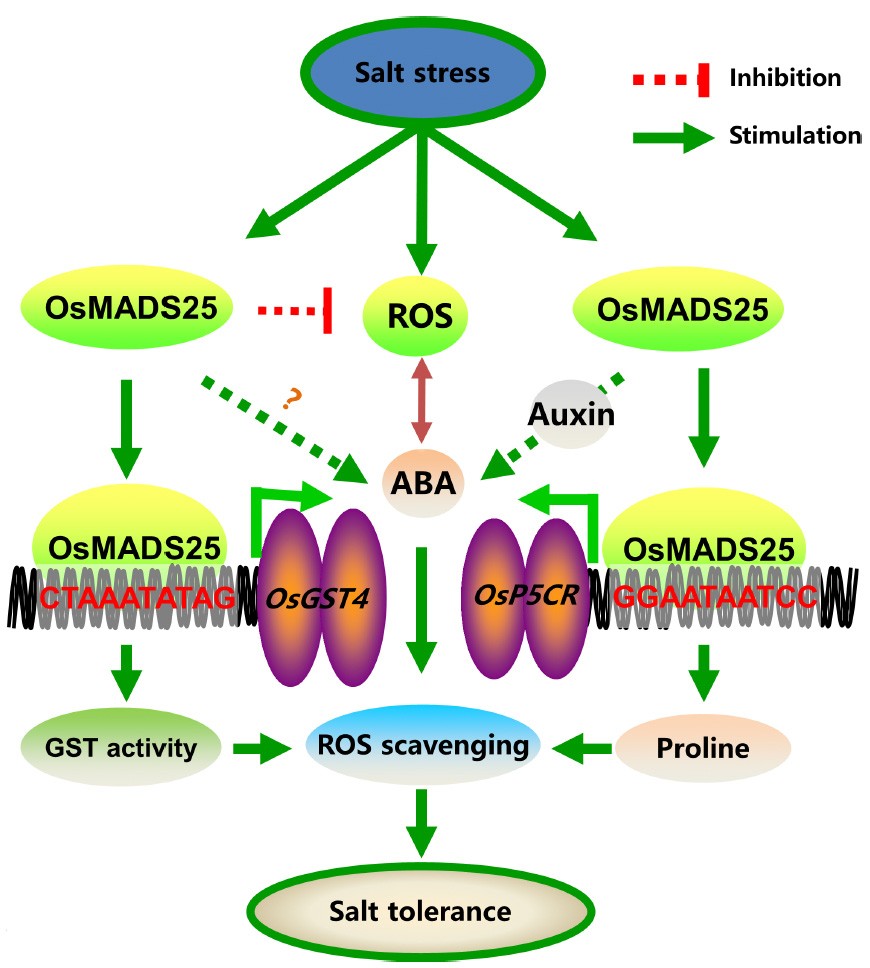博文
PLoS Genetics:水稻OsMADS25调控根生长和盐胁迫抗性
||
Rice transcription factor OsMADS25 modulates root growth and confers salinity tolerance via the ABA-mediated regulatory pathway and ROS scavenging
First author: Ning Xu; Affiliations: Chongqing University (重庆大学): Chongqing, China
Corresponding author: Junli Huang (黄俊丽)
Plant roots are constantly exposed to a variety of abiotic stresses, and high salinity is one of the major limiting conditions that impose (强加) constraints on plant growth. In this study, we describe that OsMADS25 is required for the root growth as well as salinity tolerance, via maintaining ROS homeostasis in rice (Oryza sativa). Overexpression of OsMADS25 remarkably enhanced the primary root (PR) length and lateral root (LR) density, whereas RNAi silence of this gene reduced PR elongation significantly, with altered ROS accumulation in the root tip. Transcriptional activation assays indicated that OsMADS25 activates OsGST4 (glutathione S-transferase) expression directly by binding to its promoter. Meanwhile, osgst4 mutant exhibited repressed growth and high sensitivity to salinity and oxidative stress, and recombinant OsGST4 protein was found to have ROS-scavenging activity in vitro. Expectedly, overexpression of OsMADS25 significantly enhanced the tolerance to salinity and oxidative stress in rice plants, with the elevated activity of antioxidant enzymes, increased accumulation of osmoprotective (渗透保护的) solute proline (脯氨酸) and reduced frequency of open stoma. Furthermore, OsMADS25 specifically activated the transcription of OsP5CR, a key component of proline biosynthesis, by binding to its promoter. Interestingly, overexpression of OsMADS25 raised the root sensitivity to exogenous (外源性) ABA, and the expression of ABA-dependent stress-responsive genes was elevated greatly in overexpression plants under salinity stress. In addition, OsMADS25 seemed to promote auxin signaling by activating OsYUC4 transcription. Taken together, our findings reveal that OsMADS25 might be an important transcriptional regulator that regulates the root growth and confers salinity tolerance in rice via the ABA-mediated regulatory pathway and ROS scavenging.
植物的根一直暴露在各种非生物胁迫中,其中高盐环境是限制植物生长的主要因素之一。本文报道了OsMADS25基因通过维持水稻的ROS内稳态在根的生长及耐盐性方面发挥重要作用。过表达OsMADS25基因显著增强了主根长度和侧根密度,而RNAi沉默则显著减少了主根的伸长,并且改变了根尖的ROS积累。转录激活试验显示OsMADS25能够直接结合到谷胱甘肽S-转移酶OsGST4基因的启动子区激活其表达。同时,osgst4突变体存在严重的生长受抑制表型,对于盐和氧化胁迫具有很高的敏感性,并且重组的OsGST4蛋白在离体的条件下具有清除ROS的活性。过表达OsMADS25基因显著增强水稻对于盐和氧化胁迫的耐受性,并且转基因植株中氧化还原酶的活性提高、渗透保护溶质脯氨酸的积累增加、开放气孔的频率降低。此外,OsMADS25会特异性结合到OsP5CR基因的启动子区以激活其转录,OsP5CR基因是脯氨酸生物合成通路上的一个关键基因。有趣的是,过表达OsMADS25基因增加了根对于外源ABA的敏感性,并且盐胁迫下ABA依赖性的胁迫响应基因的表达受到显著上调。另外,OsMADS25貌似还能够通过激活OsYUC4基因的表达来促进生长素信号。综上,本文的研究揭示了OsMADS25基因是水稻中的一个非常重要的转录调控因子,通过ABA介导的调控通路和ROS清除调控根的生长。
通讯:黄俊丽(http://bio.cqu.edu.cn/info/1018/1162.htm)
个人简介:2003年,中国农业大学,博士。
研究方向:植物生长发育调控;植物抗逆分子机制;分子生物学与基因工程。
doi: https://doi.org/10.1371/journal.pgen.1007662
Journal: PLoS Genetics
Published: 10 October, 2018
(P.S. 原文下载:链接:https://pan.baidu.com/s/1qFiSsqwlF_7JjmGMbedfhQ 密码:dmu6)
https://blog.sciencenet.cn/blog-3158122-1141828.html
上一篇:Plant Cell:拟南芥HD-Zip基因协调乙烯和生长素信号介导主根伸长
下一篇:Plant Physiology:NRT1.1的信号功能调控植物对铵胁迫的响应
全部作者的其他最新博文
- • Plant Physiology:CsMADS3促进柑果中的叶绿素降解和类胡萝卜素合成(华中农业大学)
- • Molecular Plant:LBD11-ROS反馈调节作用于拟南芥的维管形成层增殖和次生生长(浦项科技大学)
- • Science Advances:根结线虫通过调控植物的CLE3-CLV1模块,促进侵染进程(日本熊本大学)
- • Nature Communications:油菜素内酯参与植物营养生长期转变的分子机制解析(浙江农林大学)
- • Current Biology:光合作用产生的蔗糖驱动侧根“生物钟”(德国弗莱堡大学)
- • PNAS:花同源异型基因在叶中被抑制、花中被激活的分子机制(南卡罗来纳大学)

